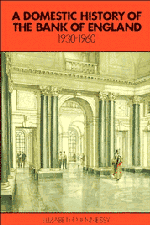Book contents
- Frontmatter
- Contents
- List of illustrations
- Foreword
- Acknowledgements
- Introduction
- 1 The Bank at war
- 2 The Accountant's Department
- 3 Exchange Control, 1939–1957
- 4 The note issue
- 5 The Printing Works
- 6 The Banking Department and the profitability of the Bank
- 7 The Cashier's Department
- 8 The Branches
- 9 Overseas, Economics and Statistics
- 10 The Establishment Department
- 11 The Secretary's Department
- Appendix Governors, Deputy Governors, Directors and Senior Officials, 1930–1960
- Notes
- Index
- Plate section
- Frontmatter
- Contents
- List of illustrations
- Foreword
- Acknowledgements
- Introduction
- 1 The Bank at war
- 2 The Accountant's Department
- 3 Exchange Control, 1939–1957
- 4 The note issue
- 5 The Printing Works
- 6 The Banking Department and the profitability of the Bank
- 7 The Cashier's Department
- 8 The Branches
- 9 Overseas, Economics and Statistics
- 10 The Establishment Department
- 11 The Secretary's Department
- Appendix Governors, Deputy Governors, Directors and Senior Officials, 1930–1960
- Notes
- Index
- Plate section
Summary
The first depositors with the Bank of England had a choice of three methods by which they could later obtain repayment. The amount of the deposit could be entered in the books of the Bank, and drawn upon by the depositor, who held a passbook; he could receive an ‘accomptable note’ as a receipt, and draw on that; or he could receive notes payable to bearer, like the notes issued by the goldsmith-bankers which passed freely from hand to hand in the localities where they were recognised. The bearer, or running cash note – which could be cashed in part if required – formed, as Sir John Clapham noted, ‘the bank note par excellence’ and is the direct antecedent of those in circulation today. It is clear that William Paterson and his supporters fully intended their new bank to be a bank of issue, although neither the Bank of England Act of 1694 nor the Bank's Charter make specific mention of such activity, doubtless because Paterson's first scheme had foundered on this very question which had aroused opposition from the government. Within a few hours of the sealing of the Charter the Court of Directors at its first meeting decided on the repayment methods outlined above, and the Bank has issued notes without a break since that time.
Although the Directors ordered that ‘the Running Cash Notes be printed’, and copper plates were engraved for notes of £5, £10, £20, £50 and £100, there is no evidence that these plates were ever used.
- Type
- Chapter
- Information
- A Domestic History of the Bank of England, 1930–1960 , pp. 124 - 165Publisher: Cambridge University PressPrint publication year: 1992



